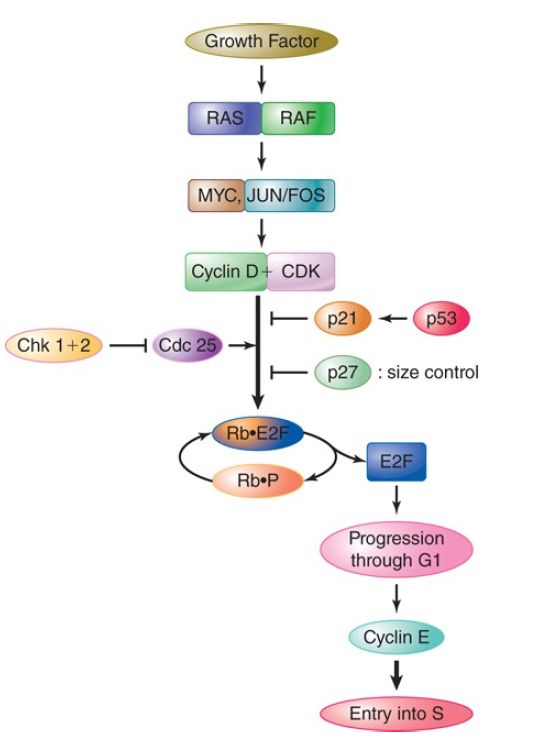
Checkpoint Control for Entry into S Phase: Rb, a Guardian of the Checkpoint
 المؤلف:
JOCELYN E. KREBS, ELLIOTT S. GOLDSTEIN and STEPHEN T. KILPATRICK
المؤلف:
JOCELYN E. KREBS, ELLIOTT S. GOLDSTEIN and STEPHEN T. KILPATRICK
 المصدر:
LEWIN’S GENES XII
المصدر:
LEWIN’S GENES XII
 الجزء والصفحة:
الجزء والصفحة:
 31-3-2021
31-3-2021
 2707
2707
Checkpoint Control for Entry into S Phase: Rb, a Guardian of the Checkpoint
KEY CONCEPTS
- Rb is the major guardian of the cell cycle, integrating information about DNA damage and cell growth.
- Rb binds the activation domains of a set of essential transcription factors, the E2F family, in the cytoplasm to prevent them from turning on the genes required for cell cycle progression.
- When Rb is phosphorylated by a cyclin/CDK complex, it releases E2F to permit cell cycle progression.
Let’s now examine how an undamaged cell progresses through G1 (FIGURE 1). A growth factor signal, executed through the signal transduction pathway, is required to turn on the gene for the first cyclin expressed, Cyclin D (humans have three different forms of this gene while Drosophila has one). Its partners, already in the cytoplasm, are CDK4 and -6. Cyclins are the positive regulators of the CDK protein kinases; by themselves CDKs are inactive. Cyclin D is required for entry into S phase. Growth factor must be continuously present for at least the first half of G1.

FIGURE 9.17 Growth factors are required to start the cell cycle and continue into S phase. The CDK-cyclin complex phosphorylates Rb to cause it to release the transcription factor E2F to go into th nucleus to turn on genes for progression through G1 and into S phase.
The key for cell cycle progression is the tumor suppressor protein Rb. Although Rb has multiple roles in the nucleus as direct regulator of chromatin structure and transcription, we focus in this section on its role in the cytoplasm as the major guardian of entry into S phase. Rb binds to the transcription factor E2F and inhibits its ability to enter the nucleus to turn on those genes required for progression through G1 and entry into S phase. Within G1 is a critical point controlled by Rb, called the restriction point or START point (different in different species), at which the cell becomes committed to continuing through the cell cycle. Ultimately, Rb integrates signals concerning both DNA damage as described in the section on p53, and cell size (or growth of the cell) pathways and is thus the key guardian of progression to S phase.
For cell cycle progression to occur, Rb must be phosphorylated by CDK/cyclin; phosphorylation of Rb releases E2F. The ultimate control of cell cycle progression is thus the regulation of CDK activity by a set of inhibitor proteins, CKIs (cyclin kinase inhibitors). p21, induced by DNA damage through p53, is a CKI. It is the major link between the DNA damage checkpoint and Rb.
Another major CKI is p27, a member of the Cip/Kip family. It is present in fairly high levels in G0 cells to prevent activation to G1. EGFR activation leads to its reduction. p27 is also activated in G1 by the cytokine TGF-3, a major growth inhibitor. p19/p16/INK/ARF is another major class of CKI proteins that control Cyclin D activity (these two different proteins, INK and ARF, are made from the same gene from alternate reading frames).
Cell size or growth of the cell is monitored by a titration mechanism. A cell entering G1 has a fixed set of different classes of CKI proteins to prevent cell cycle progression. For the cell to progress through G1, this inhibition must be overcome by the synthesis of more Cyclin D. The length of G1 is determined by how long it takes to synthesize a sufficient level of cyclins to overcome the level of CKIs.
During G1, three different cyclins are made. Cyclin D, as described earlier, is the first synthesized, activated by growth factor. As the cell continues to grow, the level of Cyclin D reaches a point of titrating out the CKIs, and the Cyclin D/cdk4/6 complex can begin phosphorylating Rb/E2F. This will cause Rb to begin to release E2F, which can then activate genes for progression through the cell cycle and ultimately S phase. Among the genes activated is the E2F gene to increase the abundance of the E2F protein and Cyclin E. Cyclin E is activated by the middle of G1, and it is also required for progression into S phase, adding to and amplifying the initial phosphorylation of Rb. Finally, just before S phase begins, Cyclin A
is synthesized, and it is also required for entry and continuation through S phase.
 الاكثر قراءة في مواضيع عامة في الاحياء الجزيئي
الاكثر قراءة في مواضيع عامة في الاحياء الجزيئي
 اخر الاخبار
اخر الاخبار
اخبار العتبة العباسية المقدسة


